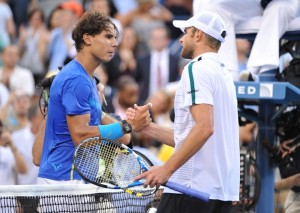NEW YORK – Solving the thunderbolts thrown his way by John Isner, Andy Murray became just the seventh man in the Open Era to reach the semifinals of all four Grand Slam tournaments in the same year.
The fourth-seeded Murray survived the power game of the 6-foot-9 (2.06m) American 7-5 6-4 3-6 7-6 (2) and earned a spot in Saturday’s semifinals at the USTA Billie Jean King National Tennis Center where he will take on defending champion Rafael Nadal of Spain, a 6-2 6-1 6-3 winner over Andy Roddick, the last American left in the men’s singles.

Roger Federer, seeking a sixth US Open title, will take on top-ranked Novak Djokovic in Saturday’s first semifinal, followed by the Murray-Nadal match.
It is the first time since 1992 that the four top seeds have reached the men’s semifinals. Nineteen years ago, No. 1 Jim Courier, No. 2 Stefan Edberg, No. 3 Pete Sampras and No. 4 Michael Chang played the penultimate match, with Edberg beating Sampras in the final.
The women’s semifinals will be played Saturday evening with top-ranked Caroline Wozniacki against Serena Williams, the favorite to capture her fourth title on the hard courts at Flushing Meadows, while ninth-seeded Samantha Stosur of Australia meets surprising Angelique Kerber of Germany, a 23-year-old left-hander who is ranked 92nd in the world.
The scheduling of the women’s semifinals continued the controversy that has engulfed the US Open since rain wiped out two days of play earlier this week. Officials put the Stosur-Kerber match on Grandstand Court – the third largest venue at Flushing Meadows – beginning at 6 p.m. (New York time). Wozniacki and Williams are scheduled to begin their semifinal at 8 p.m. in Arthur Ashe, the largest tennis stadium in the world.
Tournament officials said the Stosur-Kerber match was not played in the 23,771-seat Ashe Stadium because of the possibility of the day session with the two men’s semifinals running into the evening.
“We did not want to schedule the two women’s semifinals back-to-back in Arthur Ashe Stadium on Saturday night since the winner of the second match will need to play in the women’s singles final at 4:30 p.m. the following day,” the tournament said in a statement.
Louis Armstrong Stadium, which 10,103, was taken out of play Thursday when water bubbled up through a crack right behind one of the baselines, creating a puddle. The Grandstand seats 6,106.
The men’s final will be played on Monday.
Attempting to become the first British player to win a Grand Slam tournament singles title since Virginia Wade captured Wimbledon in 1977, Murray was able to exploit the mistakes of his opponent and easily take the opening two sets. But Isner, playing the best tennis of his career this summer, began dominating with his serve and big ground strokes.
“Somewhere along in that third set I started to get more comfortable and I started playing better,” Isner said. “I played well in the third and fourth sets. Just didn’t go my way at the end.”
The two battled evenly in the fourth set, with just a couple lapses on Isner’s part and a reflex volley by Murray separating the two.
On one point, Isner hit the service line with his second serve. Thinking it was a double fault, Murray just pushed the ball back over the net. Isner slammed the reply at Murray’s feet, but the Brit stuck out his racquet and hit a perfect half-volley into the open court for the winner.
“How often does he make that shot?” Isner asked. “If I get that point there I like my chances to serve it out. We’d still be out there right now.”
In the fourth-set tiebreak, Isner self-destructed, helped, of course, by Murray’s sharp play.
“I double-faulted at 1-all, but then he just played well,” Isner said. “I missed that gimme volley. That was bad. That hurt. … All I had to do was put it in the court because he was off the court, and I took my eye off of it.”
The netted volley gave Murray a 5-2 lead with two serves to go. Isner never got to serve again.
“It may look like you’re playing defensively or whatever, but it’s not the case,” Murray said. “You can’t take chances against someone that’s serving 140 miles an hour and their second serve is bouncing, you know, like up here, and then he’s mixing it up with 120 miles and hour second serves into your body.
“You’ve just got to try and find as way to win, and I did that.”
Roddick said his four-set victory Thursday against David Ferrer of Spain sapped all of his energy.
“It’s tough playing a lot of matches regularly, but I had zero reserves,” said Roddick, who won America’s premier tennis event in 2003. “I played a four-setter yesterday; I felt like I played six sets.
“Came out today and I just couldn’t. … Just felt like nothingness, which is unfortunate.”
Against Nadal, it’s deadly.
The Spaniard broke Roddick the first two times he served in the match and never looked back.
“I asked him how was he, but he told me ‘I am fine.’ But I think he was tired because of the match yesterday,” Nadal said. “You know how tough it is to play best-of-five two days in a row, and he played against a very difficult opponent like David yesterday.”
